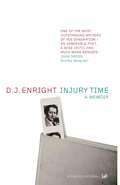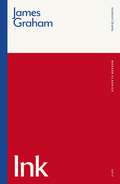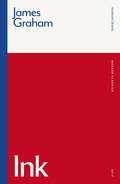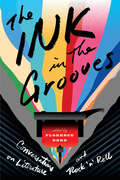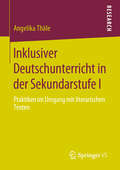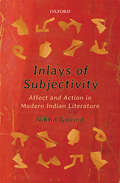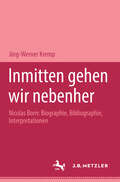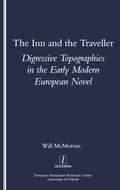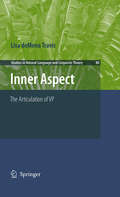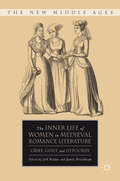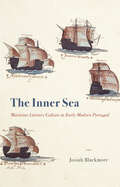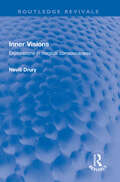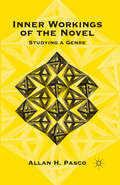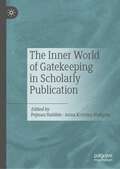- Table View
- List View
Injury Time: A Memoir
by D J EnrightThe distinguished poet, essayist and critic D. J. Enright died on the last day of December 2002. He had just put the finishing touches to Injury Time, a memoir and his third commonplace book in which the dying writer muses upon his own condition and that of the world he knows he is leaving. Comparing himself to the Chinese scholar Sima Qian, who chose an 'ignoble punishment' (in Dennis Enright's case, treatment for his cancer; in Qian's, castration) over respectable death in order to finish a book, he contemplates literature, manners, morals, people and, especially, the English language in all its glories and eccentricities - while recording his battle against cancer and his hospital experiences. Moving, and at times deeply poignant, imbued with its author's legendary humanity and wit, Injury Time is, nevertheless, funny, bracing and, above all, positive.
Ink (Modern Classics)
by James GrahamI want to tell you a story. And it's true. That's what makes it a good fucking story, right, 'cause all the best stories are true.Fleet Street. 1969. The Sun rises.James Graham's ruthless, red-topped play leads with the birth of this country's most influential newspaper – when a young and rebellious Rupert Murdoch asked the impossible and launched its first editor's quest, against all odds, to give the people what they want.Ink premiered at the Almeida Theatre in London before transferring to the West End and later Broadway. It was nominated for both the Olivier and Tony Award for Best New Play.
Ink (Modern Classics)
by James GrahamI want to tell you a story. And it's true. That's what makes it a good fucking story, right, 'cause all the best stories are true.Fleet Street. 1969. The Sun rises.James Graham's ruthless, red-topped play leads with the birth of this country's most influential newspaper – when a young and rebellious Rupert Murdoch asked the impossible and launched its first editor's quest, against all odds, to give the people what they want.Ink premiered at the Almeida Theatre in London before transferring to the West End and later Broadway. It was nominated for both the Olivier and Tony Award for Best New Play.
The Ink in the Grooves: Conversations on Literature and Rock 'n' Roll
by Florence DoreDrop the record needle on any vinyl album in your collection, then read the first pages of that novel you've been meaning to pick up—the reverberations between them will be impossible to miss. Since Dylan went electric, listening to rock 'n' roll has often been a surprisingly literary experience, and contemporary literature is curiously attuned to the history and beat of popular music. In The Ink in the Grooves, Florence Dore brings together a remarkable array of acclaimed novelists, musicians, and music writers to explore the provocatively creative relationship between musical and literary inspiration: the vitality that writers draw from a three-minute blast of guitars and the poetic insights that musicians find in literary works from Shakespeare to Southern Gothic. Together, the essays and interviews in The Ink in the Grooves provide a backstage pass to the creative processes behind some of the most exciting and influential albums and novels of our time.Contributors: Laura Cantrell, Michael Chabon, Roddy Doyle, Bob Dylan, Steve Earle, William Ferris, Dom Flemons, Rhiannon Giddens, Dave Grohl, Peter Guralnick, Amy Helm, Randall Kenan, Jonathan Lethem, Greil Marcus, Rick Moody, Lorrie Moore, the John Prine band (Dave Jacques, Fats Kaplin, Pat McLaughlin, Jason Wilber), Dana Spiotta, John Jeremiah Sullivan, Richard Thompson, Scott Timberg, Daniel Wallace, Colson Whitehead, Lucinda Williams, Warren Zanes.
Inklusion und Exklusion im Kontext prekärer Ausbildungs- und Arbeitsmarktchancen: Biografische Portraits
by Kirsten PuhrInklusiver aufgabenorientierter Englischunterricht: Kooperative Entwicklung und Erprobung eines Unterrichtsmodells in der Praxis (Literatur-, Kultur- und Sprachvermittlung: LiKuS)
by Christoph SuterGemeinsames Englischlernen in einer bunt gemischten Lerngruppe ist möglich. Ein im Schulalltag umsetzbares, gemeinsam entwickeltes und erprobtes Unterrichts- und Unterstützungskonzept, das die Arbeit mit Lernaufgaben ins Zentrum stellt, lässt Forschung, Lehrpersonen und Lernende gemeinsam Entwicklungsschritte gehen. So kommen eine solide, empirisch abgestützte theoretische Grundlage und die Bedingungen der Unterrichtspraxis zusammen, um Perspektiven für inklusive Unterrichtentwicklung zu eröffnen.
Inklusiver Deutschunterricht in der Sekundarstufe I: Praktiken im Umgang mit literarischen Texten
by Angelika ThäleObwohl fachbezogene Lehr- und Lernprozesse zu den zentralen didaktischen Herausforderungen im inklusiven Unterricht der Sekundarstufe I zählen, werden diese bislang nur selten zum Gegenstand empirischer Forschung gemacht. In dieser Hinsicht leistet die ethnographische Studie von Angelika Thäle einen wichtigen Beitrag zur empirischen Erforschung und didaktischen Weiterentwicklung inklusiven Unterrichts im Fach Deutsch. Auf der Basis teilnehmender Beobachtungen werden Praktiken im Umgang mit literarischen Texten analysiert und Ordnungsstrukturen des inklusiven Deutschunterrichts rekonstruiert. Der Fokus liegt dabei auf der Lernsituation von Schülerinnen und Schülern mit dem sonderpädagogischen Förderschwerpunkt „Geistige Entwicklung“.
Inklusiver Englischunterricht: Eine empirische Studie zum Status quo in der Sekundarstufe I
by Julia DoseDie vorliegende Studie befasst sich mit der zentralen Frage, wie derzeit inklusiver Englischunterricht an deutschen Schulen praktiziert wird. Im Fokus stehen dabei Schülerinnen und Schüler der Sekundarstufe I mit Förderbedarf im Bereich „Lernen“. Durch Interviews und eine Online-Umfrage nähert sich Julia Dose dem Thema aus der Perspektive von Lehrerinnen und Lehrern an. So werden Erkenntnisse über Konzepte und Ansätze des Unterrichts sowie über Haltungen und Einstellungen der Lehrenden gewonnen, um auszuloten, wo sich die unterrichtliche Umsetzung des Englischunterrichts auf dem Weg zur Inklusion zurzeit befindet.
Inklusiver Leseunterricht: Leseentwicklung, Diagnostik und Konzepte
by Lisa Paleczek Susanne SeifertNeben entwicklungstheoretischen Aspekten zeigt das Buch Gelingensfaktoren effektiven Leseunterrichts in inklusiven Settings auf und stellt konkrete Umsetzungsvorschläge vor. Wiederholt wird betont, dass dabei die Diversität der Voraussetzungen, die die Kinder mitbringen, stets wertschätzend Berücksichtigung finden soll. Der Inhalt Entwicklung der Lese(teil-)fähigkeiten • Zusammenhänge der Lesefähigkeiten mit anderen Fähigkeiten• Österreichischer RahmenLesePlan • Transitionsprozesse • Diagnostik von Lesefähigkeiten und anderen leserelevanten Fähigkeiten • Response to Intervention • Inklusiver Schriftspracherwerb • Fortbildungsreihe Didaktische Pakete • Fachintegriertes Leseflüssigkeitstraining Filius • Kooperative Lernmethoden • Digitalisierung im Leseunterricht • Leseförderprogramm LARS Die Herausgeberinnen Mag.a Mestre Lisa Paleczek, PhD arbeitet im Bereich Inklusion an der Kirchlichen Pädagogischen Hochschule Graz und ist Lektorin im Bereich Integrationspädagogik und Heilpädagogische Psychologie an der Karl-Franzens-Universität Graz. Lehr- und Forschungsschwerpunkte: inklusive Unterrichtsgestaltung, Erstellung differenzierter Lesematerialien für die Primarstufe, Diagnostik, Sprach- und Leseentwicklung bei Kindern mit anderen Erstsprachen. Dipl.-Patholing.in Susanne Seifert, PhD arbeitet im Bereich Integrationspädagogik und Heilpädagogische Psychologie an der Karl-Franzens-Universität Graz. Lehr- und Forschungsschwerpunkte: Leseintervention, Diagnostik von Lese- und Sprachfähigkeiten, differenzierte Lesemethoden, Lesen bei Kindern mit anderen Erstsprachen.
Inky Fingers: The Making of Books in Early Modern Europe
by Anthony GraftonThe author of The Footnote reflects on scribes, scholars, and the work of publishing during the golden age of the book. From Francis Bacon to Barack Obama, thinkers and political leaders have denounced humanists as obsessively bookish and allergic to labor. In this celebration of bookmaking in all its messy and intricate detail, renowned historian Anthony Grafton invites us to see the scholars of early modern Europe as diligent workers. Meticulously illuminating the physical and mental labors that fostered the golden age of the book—the compiling of notebooks, copying and correction of texts and proofs, preparation of copy—he shows us how the exertions of scholars shaped influential books, treatises, and forgeries. Inky Fingers ranges widely, tracing the transformation of humanistic approaches to texts in the seventeenth and eighteenth centuries and examining the simultaneously sustaining and constraining effects of theological polemics on sixteenth-century scholars. Grafton draws new connections between humanistic traditions and intellectual innovations, textual learning and craft knowledge, manuscript and print. Above all, Grafton makes clear that the nitty-gritty of bookmaking has had a profound impact on the history of ideas—that the life of the mind depends on the work of the hands.
Inlays of Subjectivity: Affect and Action in Modern Indian Literature
by Nikhil GovindInlays of Subjectivity is an incisive exposition of the theme of subjectivity and selfhood in modern Indian literature. Scholarship in Indian literary studies tends to be divided along the lines of region, language, chronology, class, and caste. This book traverses and connects these contentious lines to examine some of the most influential literary texts to emerge from India in the last hundred years. It analyses literary expressions of intense emotionality—suffering, humiliation, creativity, and strife—while inhabiting the linkages between justice, speech, and affect. Nikhil Govind interprets a range of influential novelists such as Rabindranath Tagore and Saratchandra Chatterjee (Bengali), Agyeya (Hindi), Ismat Chughtai (Urdu), Krishna Sobti (Hindi), Urmila Pawar (Marathi), and K.R. Meera (Malayalam), to unearth narrative continuities of reflexive subject positions in relation to ongoing debates around free speech and egalitarianism.
Inmitten gehen wir nebenher: Nicolas Born: Biographie, Bibliographie, Interpretationen. M&P Schriftenreihe
by Jörg-Werner KrempThe Inn and the Traveller: Digressive Topographies in the Early Modern European Novel
by Will McMorran"In the landscape of the early modern European comic novel the inn often features as a monument to digression - the perfect setting for chance encounters with strangers who always have a story to tell. This wide-ranging comparative study explores the special part played by the inn, tracing the progress of a succession of wayward heroes and narrators in five canonical texts: Cervantes's ""Don Quijote"", Scarron's ""Roman comique"", Fielding's ""Joseph Andrews"" and ""Tom Jones"", Sterne's ""Tristram Shandy"" and Diderot's ""Jacques le fataliste"". As this celebration of digressive fiction unfolds, a very different picture emerges of the novel's rise and development."
The Inn and the Traveller: Digressive Topographies in the Early Modern European Novel
by Will McMorran"In the landscape of the early modern European comic novel the inn often features as a monument to digression - the perfect setting for chance encounters with strangers who always have a story to tell. This wide-ranging comparative study explores the special part played by the inn, tracing the progress of a succession of wayward heroes and narrators in five canonical texts: Cervantes's ""Don Quijote"", Scarron's ""Roman comique"", Fielding's ""Joseph Andrews"" and ""Tom Jones"", Sterne's ""Tristram Shandy"" and Diderot's ""Jacques le fataliste"". As this celebration of digressive fiction unfolds, a very different picture emerges of the novel's rise and development."
Inner Aspect: The Articulation of VP (Studies in Natural Language and Linguistic Theory #80)
by Lisa deMena TravisFinishing this book was one of the most difficult things I have ever done. It took far too long from original idea to page proofs and suffered from being relegated to small corners of my life. It was very rarely on the front burner. Since I started working on this topic in 1991, there has been a lot of interesting work done on the areas of the articulation of VP, phrase structure mirroring event structure, the use of functional categories to represent Aktionsart, and many other areas that the research presented here touches on. The hardest thing about doing a project of this size is to accept that not everyone’s ideas can be addressed and not all new research can be incorporated. The only way that I have found it possible to let this book go to press is to reread the Preface to Events in the Semantics of English by Terence Parsons where he writes, ‘‘The goal of this book is neither completeness nor complete accuracy; it is to get some interesting proposals into the public arena for others to criticize, develop, and build on. ’’ My aim in this book is to make connections between various accounts of various constructions in various languages at the risk of treating each of these too lightly. I am grateful to too many people to thank them individually.
The Inner Life of Women in Medieval Romance Literature: Grief, Guilt, and Hypocrisy (The New Middle Ages)
by Jeff Rider and Jamie FriedmanExploration of the emotionologies of several medieval, romance emotional communities through both fictional and non-fictional narratives. The contributors analyze texts from different linguistic traditions and different periods, but they all focus on women characters.
The Inner Sea: Maritime Literary Culture in Early Modern Portugal
by Josiah BlackmoreAn expansive consideration of how nautical themes influenced literature in early modern Portugal. In this book, Josiah Blackmore considers how the sea and seafaring shaped literary creativity in early modern Portugal during the most active, consequential decades of European overseas expansion. Blackmore understands “literary” in a broad sense, including a diverse archive spanning genres and disciplines—epic and lyric poetry, historical chronicles, nautical documents, ship logs, shipwreck narratives, geographic descriptions, and reference to texts of other seafaring powers and literatures of the period—centering on the great Luís de Camões, arguably the sea poet par excellence of early modern Europe. Blackmore shows that the sea and nautical travel for Camões and his contemporaries were not merely historical realities; they were also principles of cultural creativity that connected to larger debates in the widening field of the maritime humanities. For Blackmore, the sea, ships, and nautical travel unfold into a variety of symbolic dimensions, and the oceans across the globe that were traversed in the fifteenth and sixteenth centuries correspond to vast reaches within the literary self. The sea and seafaring were not merely themes in textual culture but were also principles that created individual and collective subjects according to oceanic modes of perception. Blackmore concludes with a discussion of depth and sinking in shipwreck narratives as metaphoric and discursive dimensions of the maritime subject, foreshadowing empire’s decline.
The Inner Sea: Maritime Literary Culture in Early Modern Portugal
by Josiah BlackmoreAn expansive consideration of how nautical themes influenced literature in early modern Portugal. In this book, Josiah Blackmore considers how the sea and seafaring shaped literary creativity in early modern Portugal during the most active, consequential decades of European overseas expansion. Blackmore understands “literary” in a broad sense, including a diverse archive spanning genres and disciplines—epic and lyric poetry, historical chronicles, nautical documents, ship logs, shipwreck narratives, geographic descriptions, and reference to texts of other seafaring powers and literatures of the period—centering on the great Luís de Camões, arguably the sea poet par excellence of early modern Europe. Blackmore shows that the sea and nautical travel for Camões and his contemporaries were not merely historical realities; they were also principles of cultural creativity that connected to larger debates in the widening field of the maritime humanities. For Blackmore, the sea, ships, and nautical travel unfold into a variety of symbolic dimensions, and the oceans across the globe that were traversed in the fifteenth and sixteenth centuries correspond to vast reaches within the literary self. The sea and seafaring were not merely themes in textual culture but were also principles that created individual and collective subjects according to oceanic modes of perception. Blackmore concludes with a discussion of depth and sinking in shipwreck narratives as metaphoric and discursive dimensions of the maritime subject, foreshadowing empire’s decline.
Inner Speech - L2: Thinking Words in a Second Language (Educational Linguistics #6)
by Maria C.M. GuerreroAccording to Vygotsky (1986), The decreasing vocalization of egocentric speech denotes a developing abstraction from sound, the child's new faculty to "think words" instead of pronouncing them. This is the positive meaning of the sinking coefficient of egocentric speech. The downward curve indicates development toward inner speech, (p. 230) The purpose of this volume is to explore the faculty to "think words," not as the ability to mentally evoke words in the native (or first) language (LI) but as the faculty 1 to conjure up in the mind words in a second language (L2). To think words rather than to pronounce them is possible through inner speech, a function that humans develop in the course of childhood as they internalize the speech of the social group among which they grow. This means internalizing and being able to conduct inner speech in a particular linguistic code, the LI. But humans, at a very early or more mature age, may also come into contact and interact verbally with speakers of other languages, in classrooms or natural settings. The possibility thus emerges of internalizing an L2 in such a way that inner speech in the L2 might evolve. In this book, it is argued that, given certain conditions of L2 learning, it is possible for learners to attain inner speech in the L2. This book examines the distinctive nature of L2 inner speech and the processes that engender it and characterize its development.
Inner Visions: Explorations in magical consciousness (Routledge Revivals)
by Nevill DruryFirst published in 1979, Inner Visions discussion the nature of contemporary magical thought – encompassing the Tarot and the Qabalah – and considers its impact on the creative imagination. The author presents a fusion of the creative, magical and mythological undercurrents which are part of the ‘new consciousness’, and traces the influence of surrealist art and the expansive psychedelic period on the art and music of the 1970s. He looks, for example, at the relationship of the fantasy art on record sleeves to the electronic inner-space music which it often accompanies, and shows that this form of modern music represents one facet of the contemporary reaction against scientism and of the search for what Roszak has termed the visionary sources of our culture. The author concludes that a major mythological impulse is emerging in our culture and that magical and surreal approaches represent a profoundly invigorating and inspiring attitude linking the individual to the cosmos. This will be a fascinating read for anyone interested in magic, mythology, art, music and literature.
Inner Visions: Explorations in magical consciousness (Routledge Revivals)
by Nevill DruryFirst published in 1979, Inner Visions discussion the nature of contemporary magical thought – encompassing the Tarot and the Qabalah – and considers its impact on the creative imagination. The author presents a fusion of the creative, magical and mythological undercurrents which are part of the ‘new consciousness’, and traces the influence of surrealist art and the expansive psychedelic period on the art and music of the 1970s. He looks, for example, at the relationship of the fantasy art on record sleeves to the electronic inner-space music which it often accompanies, and shows that this form of modern music represents one facet of the contemporary reaction against scientism and of the search for what Roszak has termed the visionary sources of our culture. The author concludes that a major mythological impulse is emerging in our culture and that magical and surreal approaches represent a profoundly invigorating and inspiring attitude linking the individual to the cosmos. This will be a fascinating read for anyone interested in magic, mythology, art, music and literature.
Inner Workings of the Novel: Studying a Genre
by A. PascoPasco analyzes innovative nineteenth- and twentieth-century French works to suggest a definition of the novel, in all of its variations and difficulties: a relatively long, artistically designed, prose fiction. He permits literary aficionados to reevaluate novels through comparisons with other genres and both recent and former traditions.
The Inner World of Gatekeeping in Scholarly Publication
by Pejman Habibie Anna Kristina HultgrenThis edited book focuses on the certifiers of scientific knowledge, bringing together experts in a variety of areas in Applied Linguistics to address the complex topic of editing and reviewing in writing for scholarly publication. Drawing on insider perspectives, the authors bring to the fore personal histories, narratives and first-hand accounts of editors and reviewers and help paint a richer and more nuanced picture of the discourses, practices, experiences, success stories, failures, and challenges that frame and shape trajectories of both Anglophone and English as an additional language (EAL) scholars in adjudicating and accrediting academic output. This book will be of interest to researchers, practitioners, supervisors, writing mentors, early-career scholars and graduate students in a variety of fields.
Inneres Erleben erzählen: Zur Prosa von Mela Hartwig und Irmgard Keun, 1928-1948 (Geschlecht als Erfahrung #1)
by Marijke BoxIn der Hochphase der Neuen Sachlichkeit beginnen Mela Hartwig und Irmgard Keun ihre schriftstellerischen Karrieren. Sie setzen den Nüchternheitsdevisen ihrer männlichen Kollegen die Darstellung eines weiblich konnotierten inneren Erlebens entgegen und erzählen von den Grenzzuständen ihrer Protagonistinnen. Marijke Box geht anhand exemplarischer Lektüren den Kontinuitäts- und Transformationslinien der Prosa beider Autorinnen von der Weimarer Republik bis zum Exil und in die frühe Nachkriegszeit nach. Dabei interpretiert sie die Texte hinsichtlich ihrer Wechselwirkungen mit den historisch-gesellschaftlichen Umständen und stellt die sozialen Dimensionen des Erlebens und Erzählens heraus.
Innocence and Rapture: The Erotic Child in Pater, Wilde, James, and Nabokov
by K. OhiTaking as its focus the erotic child in decadent aesthetics, this book explores the sexual and political stakes of an aestheticistexperience of rapture. Ohi examines the power of the work of art to transport, to disorient, to move, to extort the equivocal pleasuresof self-loss. He also explores how the beautiful child offers partisans of 'art for art's sake' an emblem for the ecstatic and erotic, even the queer possibilities of art. Aestheticism's erotic child is thus in stark contrast to the innocent child of today's ideology, who secures the claims of identity against the very disorientations celebrated by aestheticism. Articulating aesthetic transport through the desiring and desired child, aestheticism interrogates the ideology underpinning sexual oppression.
